Non-Cisco Unified: Juniper Networks EX8200 Series Modular Switches
In our previous article, about the incredible Voltaire Infiniband switch, we promised to tell you a little about the distribution-level Juniper Networks switches, also used in the cloud project of our partners, Oversan-Skalaksi. Today, on the eve of the weekend, we are happy to fulfill our promise.
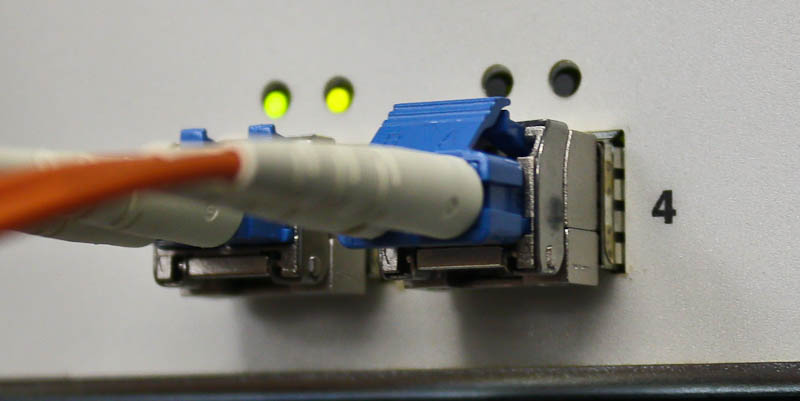
')
Juniper Networks is not as well known to a wider audience as Cisco, for example. This happens because the company does not produce entry-level products and does not have a “domestic” unit such as Linksys. Juniper products are mainly aimed at large telecommunication companies, operators and providers of various services. At the same time Juniper annual turnover exceeds $ 3 billion. Not weak, right? For a company that only serious system analysts in large integrators and multinational corporations know. Against this background, it was very surprising to see Juniper Networks advertisements on video slips at Amsterdam Schiphol Airport. Apparently, the company was thinking about raising brand awareness or something similar and equally beloved by marketers. Someone punching builds a career, not otherwise.
In Amsterdam, by the way, is the European office of the company, we were visiting there in early March, about which we published a report in the blog.
But back to our switches. In the EX8200 series, two modular chassis are available, for 8 and for 16 modules. They occupy as many as 14 and 21 units in the rack, respectively. Sizes can be represented. The total bandwidth of the switching card, the backplane, is 3.1 and 6.2 Terabits, respectively. Not 50, like the Voltaire Infiniband-matrixes, but also impressive. Each module has up to 320 Gbit / s. The chassis can have up to 768 Gigabit Ethernet ports, or up to 128 10 Gigabit ports.
Up to six hot plug power supplies can be installed in each chassis to implement N + N or N + 1 redundancy schemes. The operating system for the switch is Junos' own development (as far as I know, FreeBSD was the main system for the system). Switches provide work with 160 thousand MAC addresses and are able to organize up to 4096 VLAN subnets.
The Oversun-Skalaxi uses the eight-module EX8208 chassis. Their main task is to receive external and inter-client traffic. That is, traffic from clients passes through the switches to the outside and vice versa. Using switches, it is easy to pass traffic through a firewall on multiservice gateways (Juniper's SRX3600) or organize a VLAN to isolate segments or individual clients. This is useful, for example, for organizing a quarantine VLAN in case of a DDoS attack on one of the clients - in this case it will not affect the others.
Two switches are connected by a 40-gigabit optical channel, so traffic in principle does not have to be “brewed” in only one switch, data is easy to drive back and forth, in accordance with expediency. At the same speed, the switches are connected to the Voltaire Infiniband-matrix: the organization of the interaction between customers and storage rests on their shoulders.
And finally, switches can be used to organize quality of service (QoS). Depending on client agreements, with the help of QoS, you can organize transparent traffic prioritization and mark the necessary traffic as a priority, achieving a guaranteed bandwidth. This feature can be very useful, for example, in VoIP-applications.
The story turned out to be rather short due to the impossibility to fully disclose the specifics of using these serious devices, but in this case, we hope that it turned out to be interesting. The rest of the photos tell us. Switches are photographed during installation.
General form. Only three modules are installed.
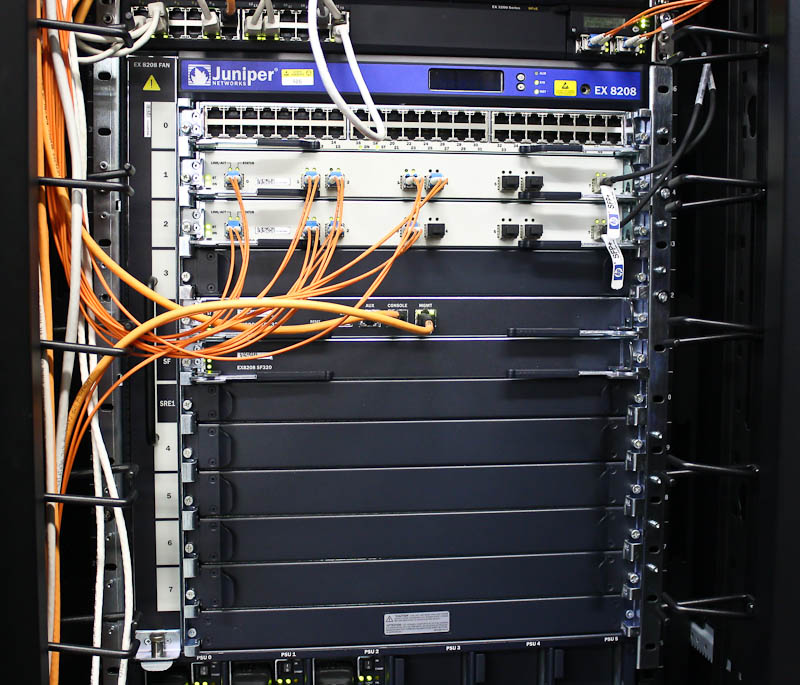
Close-up. On the left - a removable vertical fan module.

Modules close-up. As in any powerful chassis, copper and optics are quietly side by side.
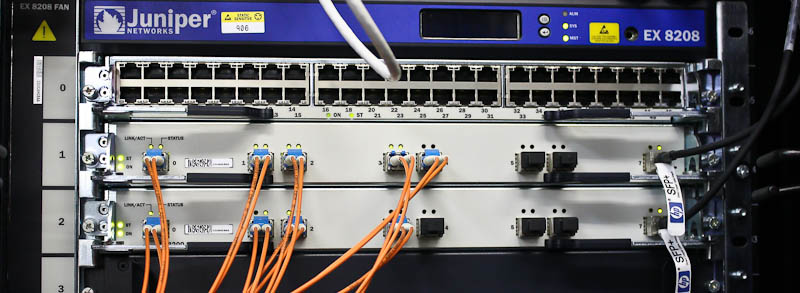
Second switch close-up.

Places for power supplies. Below is a Juniper SRX3600 multiservice gateway.
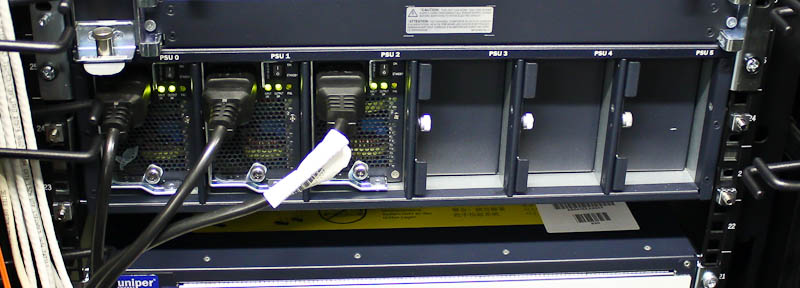


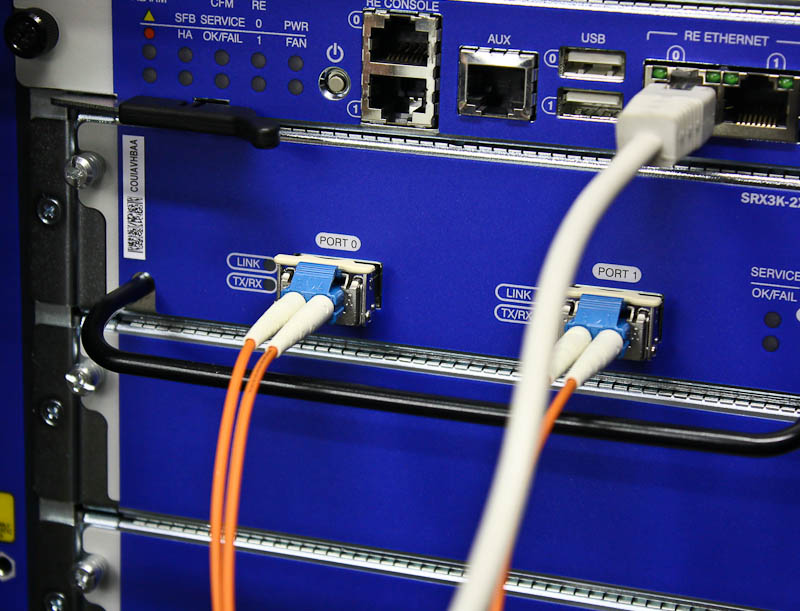

Powerful load balancer from F5. His turn will come.


')
Juniper Networks is not as well known to a wider audience as Cisco, for example. This happens because the company does not produce entry-level products and does not have a “domestic” unit such as Linksys. Juniper products are mainly aimed at large telecommunication companies, operators and providers of various services. At the same time Juniper annual turnover exceeds $ 3 billion. Not weak, right? For a company that only serious system analysts in large integrators and multinational corporations know. Against this background, it was very surprising to see Juniper Networks advertisements on video slips at Amsterdam Schiphol Airport. Apparently, the company was thinking about raising brand awareness or something similar and equally beloved by marketers. Someone punching builds a career, not otherwise.
In Amsterdam, by the way, is the European office of the company, we were visiting there in early March, about which we published a report in the blog.
But back to our switches. In the EX8200 series, two modular chassis are available, for 8 and for 16 modules. They occupy as many as 14 and 21 units in the rack, respectively. Sizes can be represented. The total bandwidth of the switching card, the backplane, is 3.1 and 6.2 Terabits, respectively. Not 50, like the Voltaire Infiniband-matrixes, but also impressive. Each module has up to 320 Gbit / s. The chassis can have up to 768 Gigabit Ethernet ports, or up to 128 10 Gigabit ports.
Up to six hot plug power supplies can be installed in each chassis to implement N + N or N + 1 redundancy schemes. The operating system for the switch is Junos' own development (as far as I know, FreeBSD was the main system for the system). Switches provide work with 160 thousand MAC addresses and are able to organize up to 4096 VLAN subnets.
The Oversun-Skalaxi uses the eight-module EX8208 chassis. Their main task is to receive external and inter-client traffic. That is, traffic from clients passes through the switches to the outside and vice versa. Using switches, it is easy to pass traffic through a firewall on multiservice gateways (Juniper's SRX3600) or organize a VLAN to isolate segments or individual clients. This is useful, for example, for organizing a quarantine VLAN in case of a DDoS attack on one of the clients - in this case it will not affect the others.
Two switches are connected by a 40-gigabit optical channel, so traffic in principle does not have to be “brewed” in only one switch, data is easy to drive back and forth, in accordance with expediency. At the same speed, the switches are connected to the Voltaire Infiniband-matrix: the organization of the interaction between customers and storage rests on their shoulders.
And finally, switches can be used to organize quality of service (QoS). Depending on client agreements, with the help of QoS, you can organize transparent traffic prioritization and mark the necessary traffic as a priority, achieving a guaranteed bandwidth. This feature can be very useful, for example, in VoIP-applications.
The story turned out to be rather short due to the impossibility to fully disclose the specifics of using these serious devices, but in this case, we hope that it turned out to be interesting. The rest of the photos tell us. Switches are photographed during installation.
General form. Only three modules are installed.

Close-up. On the left - a removable vertical fan module.

Modules close-up. As in any powerful chassis, copper and optics are quietly side by side.

Second switch close-up.

Places for power supplies. Below is a Juniper SRX3600 multiservice gateway.





Powerful load balancer from F5. His turn will come.

Source: https://habr.com/ru/post/95509/
All Articles